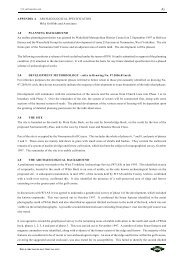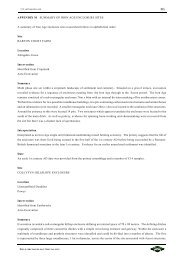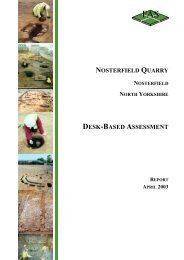ARCHAEOLOGICAL EVALUATION - Mike Griffiths and Associates
ARCHAEOLOGICAL EVALUATION - Mike Griffiths and Associates
ARCHAEOLOGICAL EVALUATION - Mike Griffiths and Associates
You also want an ePaper? Increase the reach of your titles
YUMPU automatically turns print PDFs into web optimized ePapers that Google loves.
FAS_lbf01.wpd 144<br />
8.2.28 Intervention 34<br />
Intervention 34 was situated c.16.55m to the north of<br />
Intervention 33, measured 100m x 4m <strong>and</strong> was designed to<br />
intersect a linear cropmark <strong>and</strong> several geophysical anomalies<br />
(Intervention 4, F5, Intervention 5, F35 <strong>and</strong> F36) (see Figure<br />
36). The trench was machine excavated <strong>and</strong> orientated eastwest<br />
(Plate 42). The local ground surface was relatively level<br />
at c.41.20m AOD. Ploughsoil (C1123) consisted of a<br />
yellowish-brown gravel <strong>and</strong> clayey silt <strong>and</strong> was found to be<br />
between 0.30-0.35m deep. C1123 overlay the natural subsoil<br />
which consisted of an homogenous well-drained orangishbrown<br />
gravel <strong>and</strong> clayey silt which was consistent over the<br />
whole of the trench (C1124).<br />
Plate 42 Intervention 34 looking east (scale<br />
2m)<br />
Two features were defined within Intervention 34, F48 <strong>and</strong> F50 (Figure 91). F48 was located 50.80m from the<br />
western end of the intervention <strong>and</strong> appeared as a butt-ending linear deposit of brown silt. Upon excavation it<br />
proved to be a possible butt-ending feature with moderately sloping sides <strong>and</strong> measuring 1.00m wide x 2.00m<br />
visible length (Figure 92). F48 had been backfilled once with C1246, a firm brown s<strong>and</strong>y silt with rare mixed<br />
gravel <strong>and</strong> pebble inclusions which was otherwise sterile. F48 was interpreted as a possible furrow or ditch;<br />
no dateable material was recovered during excavation.<br />
F50 was situated 24.60m from the eastern end of the intervention <strong>and</strong> was defined as a circular deposit of brown<br />
s<strong>and</strong>y silt. The feature was half-sectioned east-west <strong>and</strong> the southern half removed where it proved to be a pit<br />
measuring 1.40m in diameter but only 0.19m deep (Figure 93). The pit had been backfilled once with C1248,<br />
a brown s<strong>and</strong>y silt deposit which was flecked with mineralisation throughout. The deposit had merged with the<br />
surrounding subsoil making definition <strong>and</strong> feature identification difficult. F50 was interpreted as a small<br />
possible pit; no dateable material was recovered during excavation.<br />
8.2.29 Intervention 35<br />
Intervention 35 was situated towards the central area, <strong>and</strong> the<br />
southern boundary, of Zone A (see Figure 36). The trench was<br />
machine excavated <strong>and</strong> measured 100m x 4m, orientated northsouth<br />
(Plate 43). Ground surface within the area of the trench<br />
was 40.90m AOD. The yellowish-brown gravel <strong>and</strong> clayey silt<br />
ploughsoil (C1123) was found to be c.0.30m deep. This overlay<br />
the natural subsoil which consisted of an homogenous orangishbrown<br />
gravel <strong>and</strong> clayey silt subsoil which included areas <strong>and</strong><br />
b<strong>and</strong>s of mineralisation throughout the trench (C1124).<br />
No features were defined within Intervention 35.<br />
Plate 43 Intervention 35 looking south (scale<br />
2m)<br />
FIELD ARCHAEOLOGY SPECIALISTS







